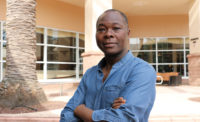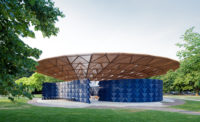In the remote West African village where architect Diébédo Francis Kéré grew up—in a region dominated by semi-arid bushland and blistering heat—the neem tree doesn’t just offer protection from the sun. It serves as a community focal point, a place where residents of all ages converge to relax, eat meals, and discuss matters large and small.
“It is a very important gathering space in my village,” says Kéré, who today splits his time between his hometown in Burkina Faso and his adopted city, Berlin, where he runs an eponymous firm. “It’s where everyone comes together.”
Kéré drew inspiration from this tree-shaded gathering spot for his latest project: the 2017 Serpentine Pavilion, scheduled to be constructed this June in London’s Kensington Gardens. Unveiled yesterday, Kéré’s scheme calls for a large canopy structure rising up from a circular plaza that is surrounded by patterned wood walls.
“I wanted to create a place that will embrace people, and will protect them from the elements while also connecting them to their environment,” he told RECORD.
Kéré joins a number of high-profile architects who have designed summer pavilions for the Serpentine Gallery since the program’s launch in 2000. Each year, the art institution commissions an international architect who has not yet completed a building in London to conceive a 3,229-square-foot temporary pavilion to serve as an events venue, a cafe, and a popular attraction. Many of Kéré’s predecessors are Pritzker Prize winners, including Zaha Hadid, Peter Zumthor, Jean Nouvel, Rem Koolhaas, and Toyo Ito. Last year, Bjarke Ingels’ installation—a sculptural enclosure made of translucent blocks—drew more than 250,000 people, making it one of the most-visited pavilions to date, according to the gallery.
Kéré is the first African architect selected for the coveted commission. He was chosen by the Serpentine Gallery’s CEO, Yana Peel, and artistic director, Hans-Ulrich Obrist, with British architects David Adjaye and Richard Rogers serving as advisors. “It’s a great honor to be selected,” says Kéré. “I’m very excited and, at the same time, very humbled.”
It’s an honor he never anticipated growing up in Gando, a rural Burkinabé village where poverty and illiteracy are commonplace. As the eldest son of the village chief, the young Kéré was afforded the chance to attend school in a nearby city and later won a scholarship to study in Germany, where he earned his architecture degree. In 2001, he completed his first building: a primary school in Gando, which received an Aga Khan Award—the first of many accolades bestowed upon Kéré for his commitment to creating low-cost and dignified architecture in his homeland. His portfolio has grown steadily over the years; the recently completed Lycée Schorge, a secondary school in Koudougou, is his largest building to date.
Beyond Africa, Kéré has produced a number of installations in Europe and the United States, including a pop-up store for Vitra’s campus in Germany and an installation for the 2016 Chicago Architecture Biennial. He has been the subject of two solo exhibitions: one staged last year at the Philadelphia Museum of Art, and one currently on view at the Munich Architecture Museum. In April, he will deliver a keynote address at the American Institute of Architects’ national convention.
For his Serpentine Pavilion, Kéré has conceived a “bold, innovative structure that brings his characteristic sense of light and life” to Kensington Gardens, according to the gallery. Anchored to a polished concrete platform, the tree-like structure will have a lightweight steel framework and an expansive saucer-shaped roof made of pine slats. Daylight will pass through the canopy, creating dappled shadows on the ground below. At the core, an oculus will enable rainwater to flow down like a waterfall. The water will be funneled to a below-ground drainage system and will help irrigate the park.
To establish a mutual sense of enclosure and openness, Kéré has surrounded the tree-inspired structure with wooden walls, whose perforations will enable natural light to pass through, and whose patterning is meant to evoke African textiles. Kéré stained the walls a vibrant blue—a symbolic color in his homeland. “In the past, indigo was a powerful color,” he says. “Your best clothes were always indigo, and you wore them to celebrations.”
The pavilion will be on view from June 23 to October 8. Kéré says the team will spend the next few months perfecting the details—even the types of refreshments to be served at the cafe. “The design is finalized. Now we are filling it with life, going down to every last detail,” he says. By using a simple palette of wood, concrete, and steel, the architect aims to demonstrate that design doesn’t have to be elaborate. As he explains, “I want to show that you can use very basic elements to inspire people.”












Post a comment to this article
Report Abusive Comment